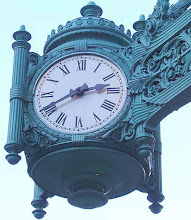Thumbing through a copy of the store's 1946 guidebook (tellingly, a guidebook for both the store and the city -- presumably as a useful service for tourists):
it occurred to me that scanning this booklet is almost like taking a walk through the store, so I thought I'd post a few. These aren't all the photos in the guidebook, but a scattered assortment for those who care to step back in time. You start on the main aisle:

If that image doesn't make you think of a cathedral I don't know what will -- the classical columns drawing your eye upward, the long collonade stretching into the distance, drawing your eye ever towards the ... door to the street.
The Jewelry and silver departments, on the main floor, Wabash side. Field's had jewelry, watch-repairing and silver workrooms on the 10th floor as well:

The Georgian Room also featured a "superb selection of antique silver, with the hallmarks of the best old English silversmiths." The Georgian room, part of the antiques gallery, was on the 9th floor:
 The fourth floor was devoted to children's wear and toys ... the latter being much preferred by young shoppers. This section, the School Girl Shop, was decorated with "pale wood, lots of light, chic red leather benches and amusing displays." If that doesn't keep a school girl from wanting to head over to the next section, "home of one of the largest collection of unusual toys to be found anywhere in the world," well, I don't know what will:
The fourth floor was devoted to children's wear and toys ... the latter being much preferred by young shoppers. This section, the School Girl Shop, was decorated with "pale wood, lots of light, chic red leather benches and amusing displays." If that doesn't keep a school girl from wanting to head over to the next section, "home of one of the largest collection of unusual toys to be found anywhere in the world," well, I don't know what will:
The guidebook didn't have a photograph of the Playroom, but here's one from just about the same time. The store itself described this room as a place "where children may be 'parked' while mothers do their shopping."

On the beloved fourth floor, the Magic Marionette Theater. Good for luring in exhausted mothers with bored children on a Saturday and giving them something to do. And, hey, if they see a toy or two they can't live without while there, well who's to complain?

The Wedding Bureau on the second floor. Descendant of the first wedding registry in the country, established in 1924 (or so the story goes, does anyone know differently?):

The Young Chicago Shop on the 6th floor. For sub-debs and school girls.

Here's one of the 28 fitting rooms there, decorated in 14 two-of-a-kind styles -- lace, bamboo, pink-and-beige, etc. -- so if the dressing room with your favorite decor is occupied, there's an identical one you can use. Also, 28 Shop special china. Ah, the luxury ...

(That's another shot not from the guidebook, but very close in age).
The Narcisscus Room restaurant, with windows facing the lake, which had fashion shows during the week, except in summer.

At this point there were five restaurants on the 7th floor (not including the pantry and the herb farm shop): The Walnut Room, the Narcissus Room, the English Room (overlooking the North Well), the self-service Crystal Buffet, and the smaller party/club meeting Wedgwood Room.

The telephone switchboard in the 12th floor. State 1000 was the number -- surely a phone number coup if ever there was one. The main store had 62 outgoing lines, 155 incoming lines and often handled an average of 70 calls per minute with the record number of calls per day more than 35,000. Not including interhouse house to the suburban branches. Man, this store loved numbers.

Also on the 12th floor, the personal shopping service for people who write or call in their orders. "No matter how far from Chicago you may be, Marshall Field & Company is no farther away than your mailbox or telephone."

The daylight candy kitchen, with white-gowned workers making candy. Sidenote: I find it interesting that although the store acquired Frangos with the acquisition of Frederick & Nelson in 1929, the Frango mint candies so famous today were not really advertised or promoted until the 1960s. I haven't found Frangos in catalogs or guidebooks or advertisements. There's one mention of a maple Frango on a menu from about 1950, but that is undoubtedly the frozen dessert:

The Store for men, across Washington St. at the southwest corner of Washington and Wabash:

They advertised the Store for Men as "A Separate Store in a Separate Building." It was just the first 6 floors (and 3 basements) of the 20-story building. They said John Shedd got the idea when he saw ladies having to endure an elevator ride in the main building with men smoking cigarettes. More likely, it was a way to get men out shopping without the, er, embarrassment of being one of the few men in a store teeming with ladies shopping.
The first floor of the Store for Men was, well, eerily similar to the main floor of the main store:

One thing this guidebook has no photographs of: the Budget Floor. Although by this point it had become the largest individual selling floor in the world. At least, according to Field's. Which was, I'm sure, fully unbiased in that.





